Asia-Pacific Wearable Medical Devices Market Size
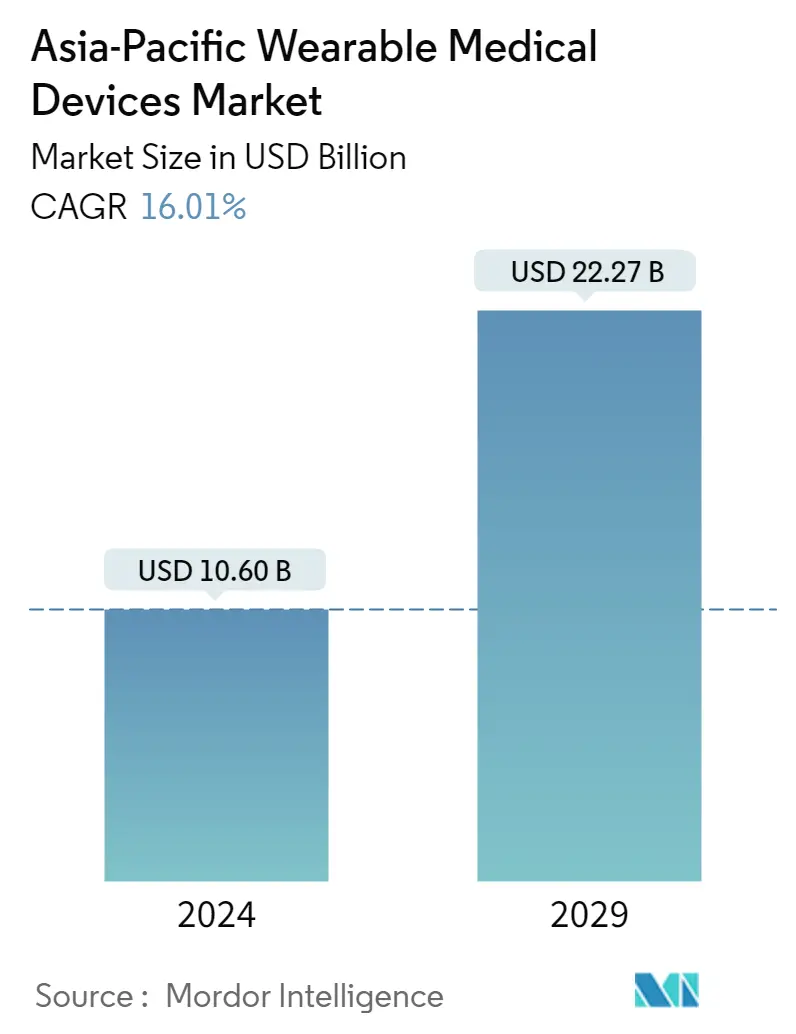
| Study Period | 2019 - 2029 |
| Base Year For Estimation | 2023 |
| Forecast Data Period | 2024 - 2029 |
| Market Size (2024) | USD 10.60 Billion |
| Market Size (2029) | USD 22.27 Billion |
| CAGR (2024 - 2029) | 16.01 % |
Major Players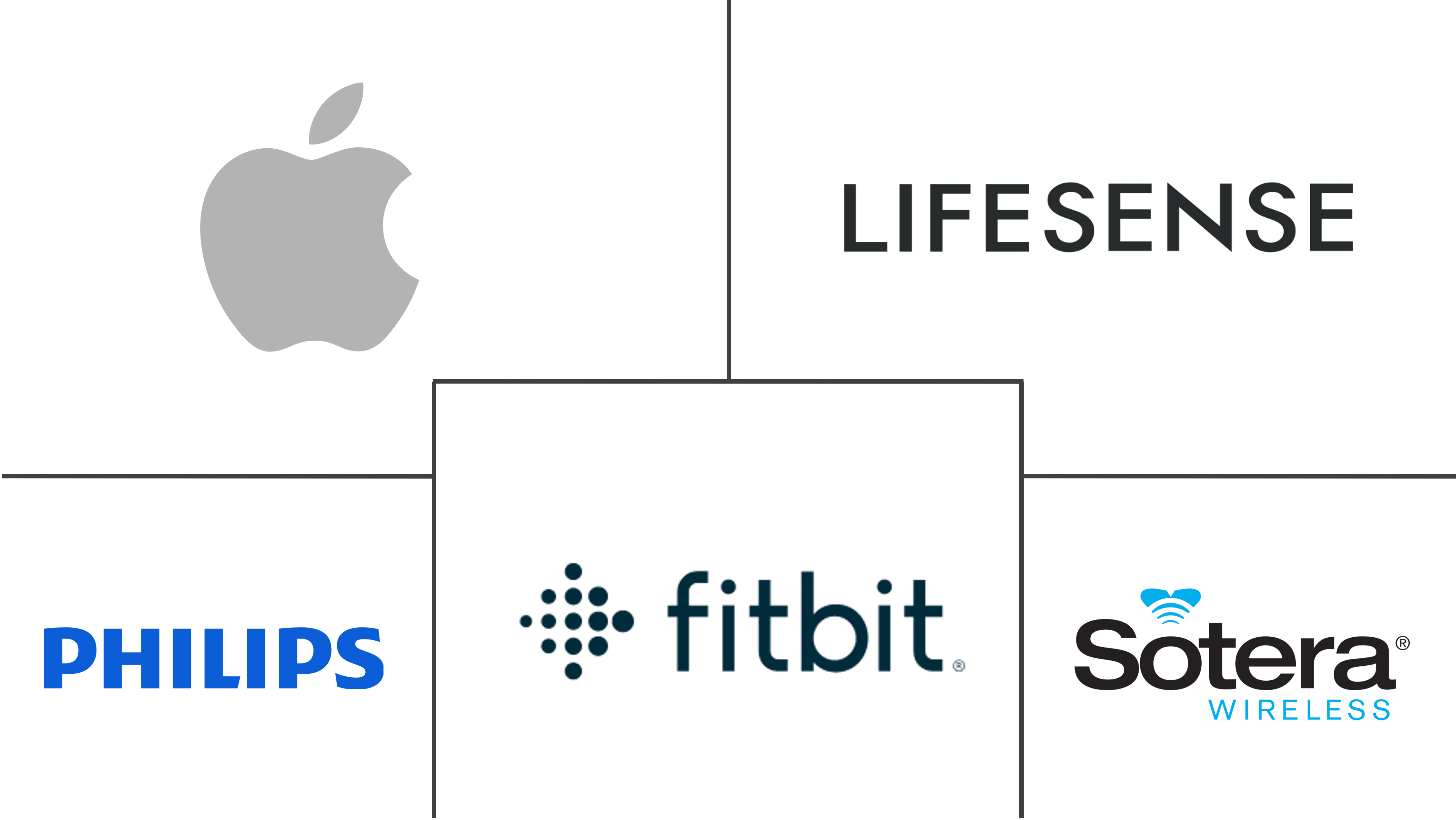
*Disclaimer: Major Players sorted in no particular order |
Need a report that reflects how COVID-19 has impacted this market and its growth?
Asia-Pacific Wearable Medical Devices Market Analysis
The Asia-Pacific Wearable Medical Devices Market size is estimated at USD 10.60 billion in 2024, and is expected to reach USD 22.27 billion by 2029, growing at a CAGR of 16.01% during the forecast period (2024-2029).
COVID-19 has expedited the technological transition in the medical device industry that is currently underway. The outbreak has resulted in an unprecedented focus on public health, which has led to an increase in preventive and long-term patient care aids and equipment at the consumer level. According to the study titled "The Rise of Wearable Devices during the COVID-19 Pandemic: A Systematic Review" published in the Journal of Sensors in August 2021, remote monitoring of COVID-19 symptoms is in high demand in healthcare. Companies manufactured a variety of IoT-based devices and wearables last year, with promising findings in terms of high accuracy in identifying patients in the prodromal phase and monitoring symptoms such as breathing rate, heart rate, temperature, and so on. Such studies demonstrate the positive impact of COVID-19 on market growth.
Currently, remote monitoring of COVID-19 symptoms is in high demand in healthcare across the region, and several companies are engaged in developing and manufacturing devices that aid in no-contact tracking of patient symptoms. For instance, in March 2021, EOFlow, a wearable drug delivery solution provider, launched a new smartphone application for integration with wearable insulin delivery devices, which has also been allowed to be sold in South Korea.
Moreover, increasing technological breakthroughs and innovations, rising per-capita wealth in developing countries, and the simplicity of use and interpretation of medical devices are all driving the regional industry forward. For instance, in December 2021, with the release of the Huawei Watch D in China, Huawei added a smartwatch to its product portfolio. It's the company's first wristwatch with a blood pressure monitor on the wrist. The Chinese Drug Administration has designated the smartwatch as a Class II medical device.
Thus, owing to the abovementioned factors, the market is expected to show growth over the forecast period. However, the high cost of the products is expected to impede the growth of the market.
Asia-Pacific Wearable Medical Devices Market Trends
This section covers the major market trends shaping the APAC Wearable Medical Devices Market according to our research experts:
Sports and Fitness Segment is Estimated to have the Significant Share in the Market
Sports and fitness devices are the most well-known and widely used healthcare wearables for monitoring vital metrics. Athletes utilize wearable equipment to monitor their heart rate, blood pressure, and other vital signs. Individuals in the Asia Pacific have begun to focus on their well-being as a result of the increased prevalence of lifestyle disorders such as obesity, stroke, type 2 diabetes, heart disease, and atherosclerosis. As a result, the number of gyms and fitness centers is increasing, which is boosting sales of wearable medical devices in the region. For instance, according to the International Health, Racquet & Sportsclub Association (IHRSA) Media Report 2021, China has the most health and fitness clubs in the region in 2020, with 27,000 clubs. In 2020, Australia had 3,715 health and fitness clubs.
The domination of this segment is due to a shift in adult preferences toward sports and leisure activities, as well as the introduction of smart and advanced wearable gadgets that track activity. Fitbit Inc., for example, released Fitbit Charge 4, its most advanced health and activity tracker, in March 2020. This new device has the most up-to-date sensors and functions, as well as built-in GPS, Spotify, and connect and control tools.
Additionally, in January 2021, OnePlus launched its first fitness band in India. The fitness band sports a 1.1-inch AMOLED display, which is almost the standard size display for a fitness band these days.
Thus, owing to the abovementioned factors, the market segment is expected to show growth over the forecast period.
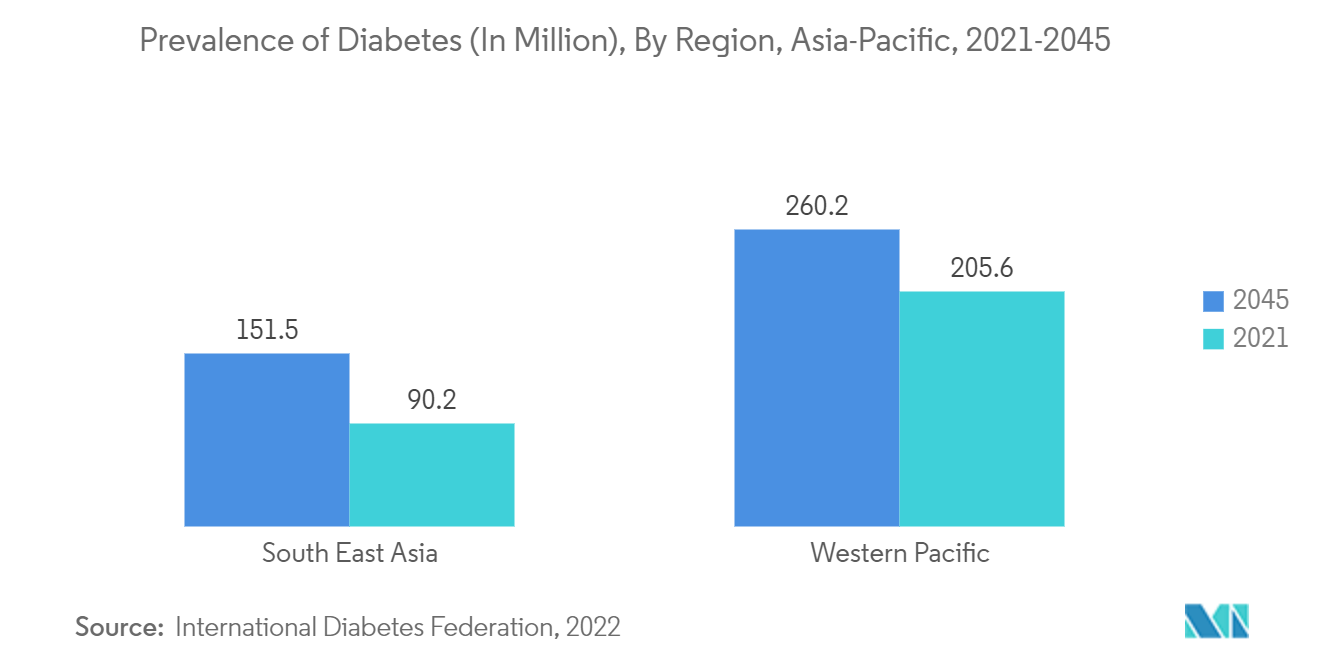
India is Expected to attain the Major Market Share in the Market
In India, a large percentage of the population has lifestyle-related diseases such as diabetes and obesity, which have increased the risk of cancer. This has raised concern levels in societies about the early diagnosis of diseases, which increases the demand for wearable devices. For instance, as per the International Diabetes Federation (IDF) Report 2021, in terms of the number of people affected by diabetes mellitus, India is second only to China. In India, the prevalence of diabetes among people aged 20 to 79 years is 9.6%. This equates to 74.19 million diabetes cases, with the number anticipated to rise to 92.9 million by 2030. There are about 53.1% of those who have never been diagnosed with diabetes. Currently, India accounts for one out of every six adults in the world who has diabetes, as per the same source.
Furthermore, the increase in cases of chronic conditions, such as obesity, heart problems, breathing problems, and many more such diseases, helps to drive the Asia-Pacific market. For instance, according to the GOQii India Fit Report 2021 released in February 2021, according to the findings of a large-scale survey done across India, the majority of those suffering from cardiac ailments in 2020 will be 60 years old or older. Teenagers accounted for roughly 6% of those with cardiac problems, while young adults accounted for only 3% of those with the ailment that year. Therefore, India's wearable medical device market appears to have a promising future on account of increased awareness of the value of exercise and a healthy lifestyle, rising chronic disease rates, and technological advancements as the main drivers of growth.
Thus, owing to the abovementioned factors, the studied market in India is expected to show growth over the forecast period.
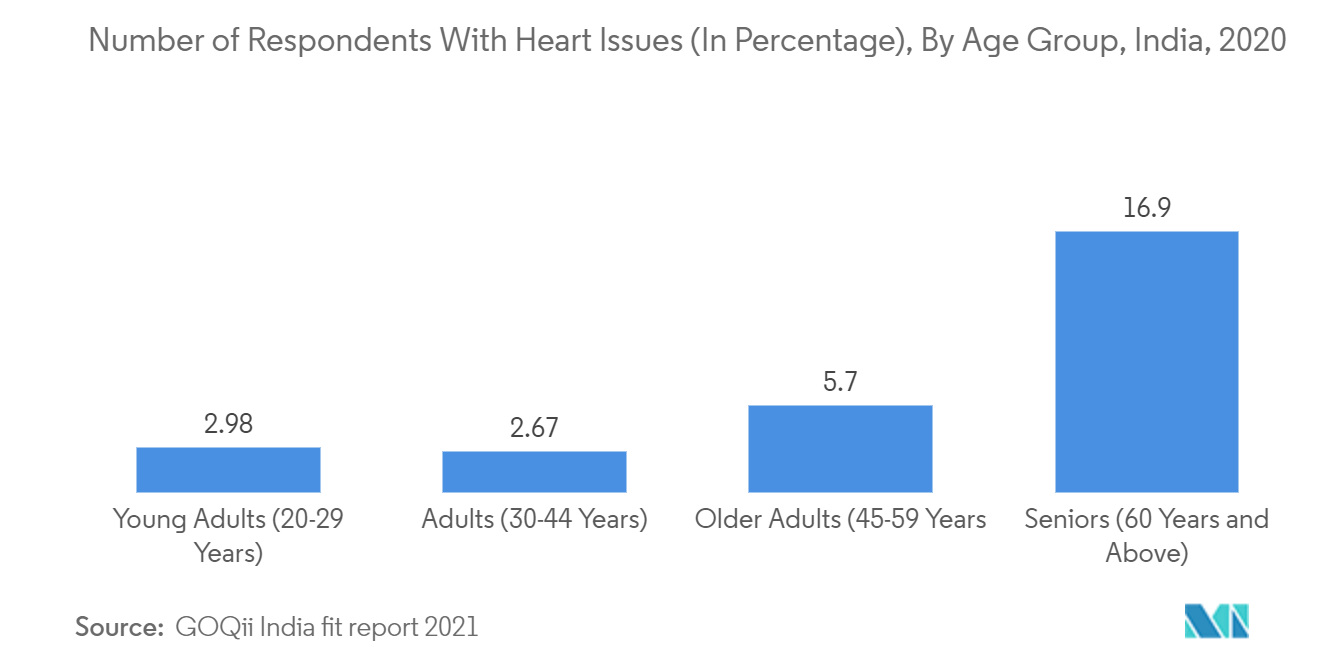
Asia-Pacific Wearable Medical Devices Industry Overview
The Asia-Pacific wearable medical devices market is fragmented and competitive. The key growth strategies adopted by key players include strategic acquisitions, collaborations, and partnerships that may help them expand their geographical presence and strengthen their business positions. Some of the companies currently dominating the market are Garmin Ltd, Apple Inc., Fitbit Inc., Lifesense, Sotera Wireless, Philips (Biotelemtry, Inc.), Samsung, Vital Connect, GOQii, and Abbott Laboratories.
Asia-Pacific Wearable Medical Devices Market Leaders
Apple Inc.
Fitbit Inc.
Lifesense
Sotera Wireless
Philips (Biotelemtry, Inc.)
*Disclaimer: Major Players sorted in no particular order
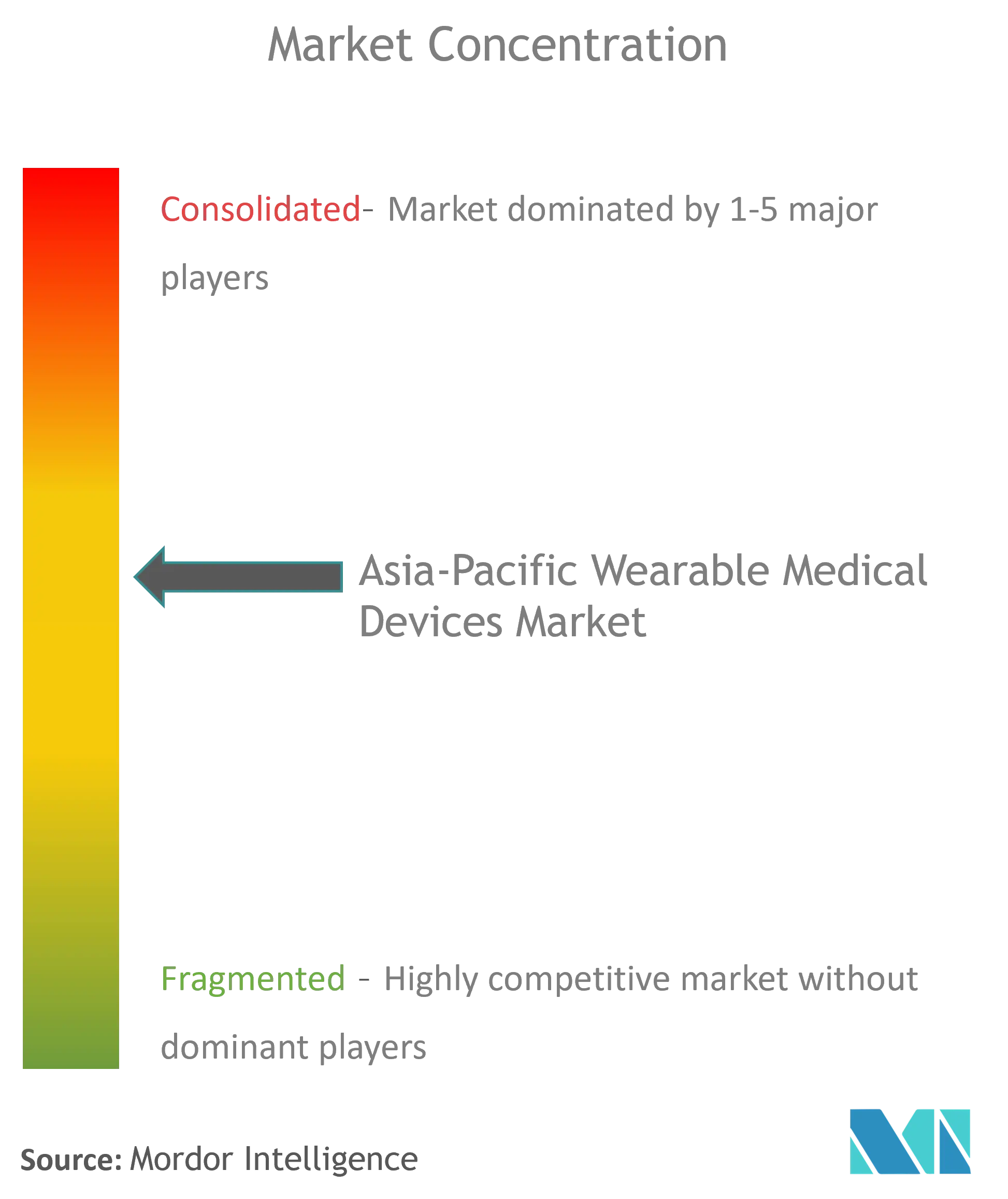
Asia-Pacific Wearable Medical Devices Market News
- In March 2022, Molife released a Pro version of the Sense 500 smartwatch in India. The Molife Sense 500 Pro has a square-shaped design and several of the same features as the normal model, including Bluetooth calling, 24-hour heart rate tracking, a 220mAh battery, SpO2 monitoring, and a 1.7-inch IPS display.
- In March 2022, BioIntelliSense commercially launched its medical-grade BioButton Rechargeable wearable device. The new BioButton Rechargeable device allows for continuous multi-parameter monitoring of a broad range of 20+ vital signs and physiologic biometrics for up to 16 days on a single charge.
Asia-Pacific Wearable Medical Devices Market Report - Table of Contents
1. INTRODUCTION
1.1 Study Assumptions and Market Definition
1.2 Scope of the Study
2. RESEARCH METHODOLOGY
3. EXECUTIVE SUMMARY
4. MARKET DYNAMICS
4.1 Market Overview
4.2 Market Drivers
4.2.1 Increasing Technological Advancements and Innovations
4.2.2 Increasing Per-capita Income in Developing Countries
4.2.3 Ease-of-use and Interpretation of Medical Devices
4.3 Market Restraints
4.3.1 High Cost of Wearable Devices
4.3.2 Unfavorable Reimbursement Issues
4.4 Porter's Five Force Analysis
4.4.1 Threat of New Entrants
4.4.2 Bargaining Power of Buyers/Consumers
4.4.3 Bargaining Power of Suppliers
4.4.4 Threat of Substitute Products
4.4.5 Intensity of Competitive Rivalry
5. MARKET SEGMENTATION (Market Size by Value - USD million)
5.1 By Product Type
5.1.1 Wearable Vital Sign Monitor
5.1.1.1 Wearable Heart Rate Monitor
5.1.1.2 Wearable Activity Monitor
5.1.1.3 Wearable Electrocardiograph
5.1.1.4 Wearable Sleep Monitor
5.1.2 Wearable Fetal Monitor and Obstetric Device
5.1.3 Neuro-monitoring Device
5.1.4 Respiratory Therapy Wearable Device
5.1.5 Glucose/Insulin Monitoring Wearable Device
5.1.6 Other Wearable Devices
5.2 By Application
5.2.1 Sports and Fitness
5.2.2 Remote Patient Monitoring
5.2.3 Home Healthcare
5.3 By Device Type
5.3.1 Watch
5.3.2 Wristband
5.3.3 Clothing
5.3.4 Ear Wear
5.3.5 Other Device Types
5.4 Geography
5.4.1 China
5.4.2 Japan
5.4.3 India
5.4.4 Australia
5.4.5 South Korea
5.4.6 Rest of Asia-Pacific
6. COMPETITIVE LANDSCAPE
6.1 Company Profiles
6.1.1 Garmin Ltd
6.1.2 Apple Inc.
6.1.3 Fitbit Inc.
6.1.4 Lifesense
6.1.5 Sotera Wireless
6.1.6 Philips (Biotelemetry, Inc.)
6.1.7 Samsung
6.1.8 Vital Connect
6.1.9 Abbott Laboratories
6.1.10 GOQii
- *List Not Exhaustive
7. MARKET OPPORTUNITIES AND FUTURE TRENDS
Asia-Pacific Wearable Medical Devices Industry Segmentation
As per the scope of the report, wearable medical devices can diagnose or monitor medical conditions when combined with digital health information worn over the body. Wearable devices are easy to use, cordless, and can provide information about various factors, such as heart rate, blood pressure, weight, sleeping habits, and other factors. The Asia-Pacific Wearable Medical Devices Market is segmented by Product Type (Wearable Vital Sign Monitor (Wearable Heart Rate Monitor, Wearable Activity Monitor, Wearable Electrocardiograph, and Wearable Sleep Monitor), Wearable Fetal Monitor and Obstetric Device, Neuro-monitoring Device, Respiratory Therapy Wearable Device, Glucose/Insulin Monitoring Wearable Device, and Other Wearable Devices), Application (Sports and Fitness, Remote Patient Monitoring, and Home Healthcare), Device Type (Watch, Wristband, Clothing, Ear Wear, and Other Device Types), and Asia-Pacific (China, Japan, India, Australia, South Korea, and Rest of Asia-Pacific). The report offers the value (in USD million) for the above segments.
| By Product Type | ||||||
| ||||||
| Wearable Fetal Monitor and Obstetric Device | ||||||
| Neuro-monitoring Device | ||||||
| Respiratory Therapy Wearable Device | ||||||
| Glucose/Insulin Monitoring Wearable Device | ||||||
| Other Wearable Devices |
| By Application | |
| Sports and Fitness | |
| Remote Patient Monitoring | |
| Home Healthcare |
| By Device Type | |
| Watch | |
| Wristband | |
| Clothing | |
| Ear Wear | |
| Other Device Types |
| Geography | |
| China | |
| Japan | |
| India | |
| Australia | |
| South Korea | |
| Rest of Asia-Pacific |
Asia-Pacific Wearable Medical Devices Market Research FAQs
How big is the Asia-Pacific Wearable Medical Devices Market?
The Asia-Pacific Wearable Medical Devices Market size is expected to reach USD 10.60 billion in 2024 and grow at a CAGR of 16.01% to reach USD 22.27 billion by 2029.
What is the current Asia-Pacific Wearable Medical Devices Market size?
In 2024, the Asia-Pacific Wearable Medical Devices Market size is expected to reach USD 10.60 billion.
Who are the key players in Asia-Pacific Wearable Medical Devices Market?
Apple Inc., Fitbit Inc., Lifesense, Sotera Wireless and Philips (Biotelemtry, Inc.) are the major companies operating in the Asia-Pacific Wearable Medical Devices Market.
What years does this Asia-Pacific Wearable Medical Devices Market cover, and what was the market size in 2023?
In 2023, the Asia-Pacific Wearable Medical Devices Market size was estimated at USD 9.14 billion. The report covers the Asia-Pacific Wearable Medical Devices Market historical market size for years: 2019, 2020, 2021, 2022 and 2023. The report also forecasts the Asia-Pacific Wearable Medical Devices Market size for years: 2024, 2025, 2026, 2027, 2028 and 2029.
Asia-Pacific Wearable Medical Device Industry Report
Statistics for the 2024 Asia-Pacific Wearable Medical Device market share, size and revenue growth rate, created by Mordor Intelligence™ Industry Reports. Asia-Pacific Wearable Medical Device analysis includes a market forecast outlook to 2029 and historical overview. Get a sample of this industry analysis as a free report PDF download.
